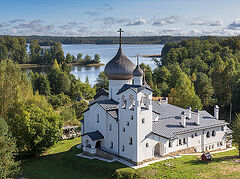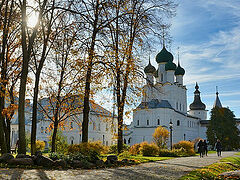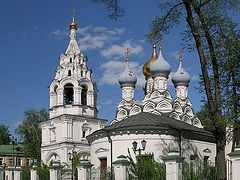Fewer than 800 people live in the village of Strigay, located in the Bazarny-Karabulak district of the region of Saratov. Its main attraction is a ruined church which, even after a century of desolation, still amazes visitors with its grandeur: its huge size, the beauty of its architecture and the quality of its bricks and wrought-iron railings. According to preliminary estimates, its restoration will cost 50 million rubles (around $650,000), and that estimate does not cover painting, or the purchase of furnishings and an iconostasis. It is hard to imagine how much strength and resources will be required to bring this church back to life. As Priest Dionisy Kamenshchikov—rector of the Church of the Prophet Elias in Saratov—says, history is a good teacher. The Church of St. Nicholas in Strigay was built in 1907 by parishioners, and Fr. Dionisy believes that it is possible even today: he has gotten the parishioners of his own church, located about seventy-five miles away from the village, involved in the restoration work.
 The Church of St. Nicholas in Strigay
The Church of St. Nicholas in Strigay
The Land of St. Nicholas in “the Switzerland of Saratov”
Once I started thinking that our parish needed a task that would unite everyone. It became clear that one option could be restoring a ruined village church. I started searching and found a church in Strigay that immediately struck me. The thing is that it’s located in the Bazarny-Karabulak district, an area that we call the “Switzerland of Saratov.” There are very beautiful places with coniferous forests here—something very uncommon in the Saratov region, which is dominated by steppes. What makes this area so special is that it can be called the “land of St. Nicholas,” as nine out of ten churches in this area are dedicated to him, with some rare dedications to the Archangel Michael. Such was the veneration of St. Nicholas the Wonderworker in this land!
We made the first “test” drive with my family. The distance between our house and the village is about seventy-seven miles one way, the whole trip is 155 miles, so not very close. Upon arriving we saw a huge church: its area is almost 6500 square feet. It is enormous even for a city. We performed a prayer service there.
When I told the parishioners about the church, everyone got enthusiastic about the idea to start working on its restoration. Once we began to travel and clear the area with our own hands, it became clear that everyone really needed this, it became possible for us to work for the glory of God.
We started work last year. Some members of our youth group came here, cut down and removed the trees that were growing right in the church. This was the starting point.
Between twenty and thirty people are now involved in restoring the church. These are mainly our parishioners; there are also builders from the neighboring village. One of them has already built a church in a neighboring village, and even though he is elderly, he has a youthful zeal. He’s waiting for us to get the electricity set up so that he can get started.
Another interesting point. Our St. Elias Church is new: it was reconstructed on St. Elias’ Square in Saratov next to the place where the old St. Elias Church had been before it was destroyed after the Revolution. Now there are schools on that site, so it was impossible to rebuild it on its original site. The new St. Elias Church is four or five times smaller than the original one, which also had an altar dedicated to St. Nicholas. Now I like to joke that the Revolution ‘exploded’ in such a way that one side-altar flew seventy-five miles away from us. Now this church is attached to ours.
Not by logic, but by the call of the heart
When asked why I am doing this and who needs it, I answer that I need it, but I can’t explain it logically. Objectively, the village is dying. If you drive down the street, you can see that only one in every three houses is inhabited; both young and middle-aged residents have left. From a secular point of view, the restoration of this church is completely illogical and doomed to failure. Even if it is restored, what next if the village is dying?
True, it would be easier and cheaper to build a small church in the city, and it would support itself. In theory, of course. In practice, it is much easier to restore a church in ruins. Anyone who sees these magnificent ruins can’t remain indifferent and sincerely wants to take part. We provide them with such an opportunity, by donations and by our joint efforts.
Our parish is located in the center of Saratov and all is well with the churches in our city—there are a lot of them. We are rebuilding the village church guided not by logic, but by the call of our hearts. Not only me, but all our parishioners are involved in this process. It is very expensive to maintain such a church, heating in winter alone will cost over 100,000 rubles ($1,300) per month. This is a huge sum, but if the Lord gives you the opportunity not to pass by a church like this, but to try and revive it, well then try you must.
We made a draft design, calculated the cost of restoring its floor, domes, doors and windows—it would come out to about 25 million rubles ($32,000). The same amount is needed to complete the construction. It's scary to think how much money will be needed for utensils, an iconostasis and painting.
We are planning to start with the restoration of the masonry. You can see in the photographs that the church has no roof. Snow, rain and fluctuations in temperature will negatively affect the masonry; so restoring the masonry is a primary task, and after that we will take on the rest of the work. When it gets warmer, it will be possible to start working.
When the Lord blesses a person to take part in the restoration of a shrine, a church or a monastery, He shows him great mercy. If we look at the Holy Scriptures, God didn’t allow the Prophet David to build the Temple—it was built by his son Solomon.
God didn’t bless the man who wrote the Psalter—whose psalms are among the most important elements of Orthodox worship—to build the Temple!
The Lord told him through a prophet, “You have shed much blood—you will not build the Temple, but your son Solomon will.” We must all bear this in mind: When God allows someone to build or restore a church, this is the greatest mercy, and this is necessary first and foremost for the person himself.
A new reality and possible prospects
When I think about the future of this church, I see several paths. The first is the most realistic one—to open a small convent there, with the church as its center. But it would be wrong on my part to talk about such a serious matter ahead of time. I pray about it, and we want to do it if God provides. If a convent grows here, there will be prayer, pilgrims, the village will flourish.
The second path is associated with the social processes that the pandemic triggered. People suddenly found that it is possible to work and earn money online. At the same time, many say, “I would go to the country and raise children there, but how would I provide for them?” However, city residents don’t understand that being a farmer means very hard work.
The world has changed over the past year, and new opportunities have appeared. The process can begin when strong, enterprising and active young people move from large cities to rural areas. They can live well there—there are no traffic jams or problems with parking; the air is clean and you can grow fresh vegetables in your garden; you can build the house you want; and children will study online. Another positive aspect is that this process can contribute to population growth. If you give birth to another child in the village, you just add another room. Every cloud has a silver lining—the pandemic is opening up a new reality for us, and for the Church too.
Rural churches can be in demand in these conditions. If I don’t live to see this or the Lord ordains otherwise, our parishioners will have no alternative than to continue and finish this work.
It is also important because people want to be prayed for in such old churches. With God nothing is impossible. St. Nicholas is known as the “Wonderworker” because he can do inexplicable things from the point of view of human logic.
History is a good teacher
Before the Revolution, about 4,000 people lived in this village. The church was built in such a way that two side-altars could be added to it. It was possible to disassemble the masonry and enlarge it. At the turn of the century there was a huge increase in the population. This process had begun during the reign of Alexander III and gave a serious impetus to economic growth. Villages in those days grew by leaps and bounds. We were told that our ancestors, villagers, were extremely poor; but this nation of “paupers” built such giant churches with their own money! Then the Revolution came with all its consequences.
Why is it important to know the history of your country, the place where you live, and your parish? To understand the way our ancestors lived, worked and loved their churches. Looking at these glorious ruins, at this huge work (at a time when there was no transport, no technology), it is hard to believe that this enormous church was built with donations from ordinary people. One can marvel at these people’s piety and love for the house of God and learn from them. History is a good teacher for someone who wants to learn. Our ancestors did what seems inconceivable for us today.
Looking at these destroyed churches, you start to wonder what must have happened to the people that they brought their churches into such a state? It was not Dzerzhinsky or Lenin who came to the church and destroyed it. All this was done by ordinary people.
In the 1990s, our villagers continued this “work”—they tried to dismantle the church and pull out the railings with a tractor but didn’t succeed. History teaches a lot to those who want to learn from it ... How can people prosper in a place where there is a ruined church, where a chicken coop is made of church bricks? Can such a village flourish? This is unnatural.
The guardian angel stays in the church until the end of time
From Church Tradition, we know that every church has its guardian angel. Even if the church is destroyed, the angel remains there until the end of time.
There is an interesting story on this subject in the Life of St. Joasaph of Belgorod. Once during a meeting of the clergy of Belgorod and its surrounding area, he saw a 130-year-old priest, whose longevity aroused his interest. After a conversation with him, the saint learned that the elder priest had once committed a grave sin and needed repentance. He had served in a village. On one feast day, he first celebrated the early Divine Liturgy, and, fearing that he would be punished by his landowner, he celebrated the late (second) Divine Liturgy for him on the same day, which is forbidden by the canons. After the Proskomedia, he heard a voice saying to him, “Stop, what are you doing? Do not dare or you will be damned.” Without thinking, the priest replied boldly, “No, you’ll be damned!” and continued celebrating the Liturgy. Hearing this story, St. Joasaph said, “What did you do?! You cursed an angel of God, the guardian of that place. Both of you are bound by the curse. This is the reason for your longevity.”
The saint took the priest to the place where the church had once stood. There they celebrated the Liturgy, and at the end, St. Joasaph called the priest forth and commanded him to read “Lord, now lettest Thou Thy servant depart.” After that, he blessed the elderly priest and said, “I forgive and absolve you of all of your sins.” Having been reconciled with God, the angel, and his conscience, the priest, still standing in his vestments, became weak and, falling before the altar where he had just offered the Sacrifice, commended his spirit to God.
It is important to note that they went to the exact spot where the sin had been committed. This story confirms that even if a church is destroyed and there is now a wasteland there, the Guardian Angel remains there forever and protects this place.
When the Liturgy is celebrated again in a revived church or monastery, even the environment changes. I knew a priest who served in a monastery where in the Soviet era there had been a psychiatric clinic. He told me what an oppressive atmosphere there was—he constantly wanted to sleep, he had no energy for anything. He forced himself to celebrate the Liturgy as often as possible, and after a short time everything started improving: pilgrims began to arrive and, most importantly, the depressing atmosphere was dispelled.
I’ll say it again: people won’t live happily if they have a destroyed church near them, covered with obscene language graffiti, with dogs living in its altar. How can you count on God’s blessing and a normal life when you treat your church like that?
Restoring a church, you restore the ruins of your soul
How do you start rebuilding a destroyed shrine?
First, ask God for His blessing in your prayers.
Secondly, you shouldn’t start this work with the thought that you will do much good for someone else—first and foremost, you need this work yourself. While restoring a church, you are restoring the ruins of your soul, which has been destroyed by sin. There can be no other motivation.
Thirdly, it is important to move quickly from words to deeds. Many will look at the ruins and lament, “If only some sponsor would appear, someone would come and do something.” Nobody will do anything for us! And we don’t know how God will decide: there are many cases when everything was razed to the ground, and now there is a prosperous monastery. And such miracles are happening before our eyes.
Fourthly, you need to have a heart that is aflame and a head that is sober. None of this can be done on an impulse, as it takes many years. You must be ready to give the best years of your life. You need to have energy and good physical strength, but at the same time you need to be able to manage finances prudently, and to do so, you need to mature. You must have God’s blessing for everything to come together.
Now we are raising funds for bricks, then we’ll lay them, and then we need to make a new roof; and if we don’t, the process will go backward—the walls will collapse. Everything that people donated can be lost. Then you need to make the floor quickly, install the windows, doors and water pipes.
It is necessary for the church to live and for the Liturgy to be celebrated. When you start rebuilding a church, you need to have the determination to stand to the very end. This path will end only when your life ends or if God blesses you for another service. There is a point of no return in this work. But even if you try to do something and don’t succeed, you must accept it with humility—at least you did everything that you could.
My parishioners and I noticed that a fullness of being and the taste of life opened up for us exactly when we began to visit Strigay. Living in the city, we can’t even see the sky, and these rides to the village have become a time of rest and a festive occasion for us. Once you get there, you see a completely different life—something that can’t be explained until a person tastes it for himself. The Lord really gives and comforts; He gives grace to all who become involved in the restoration of the holy church!









